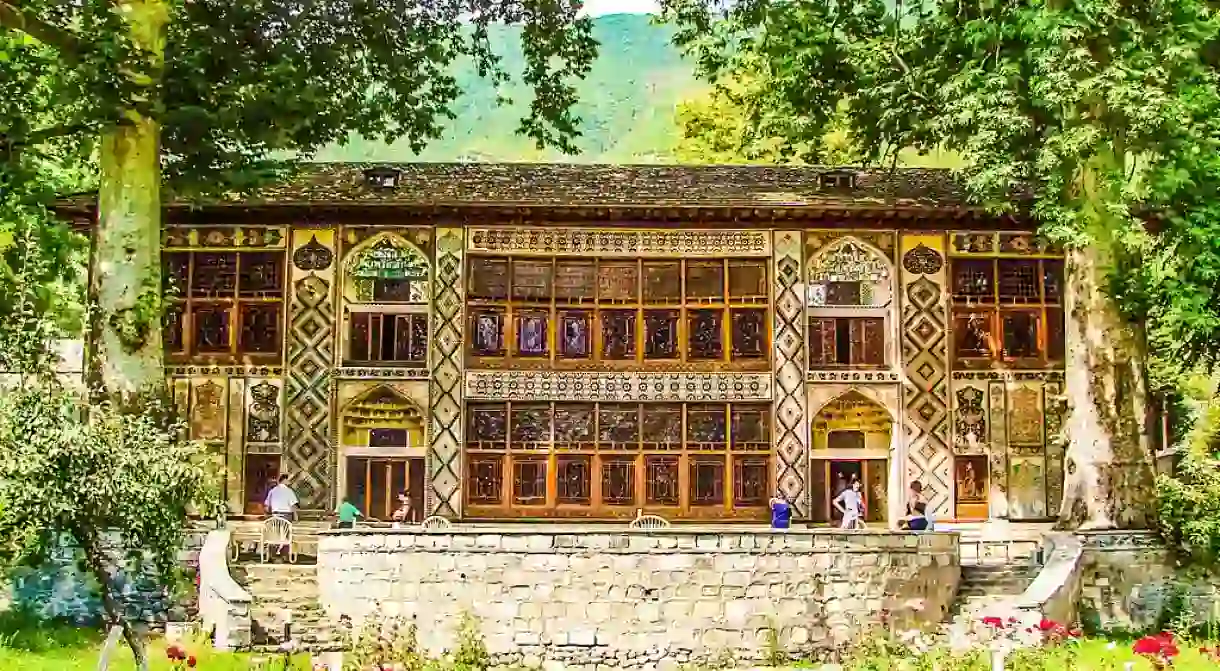A Two-Week Travel Itinerary to Azerbaijan

The Land of Fire covers nine climatic zones, is home to an almost-forgotten Jewish settlement, and has several medieval old towns. Few know anything about this eastern Caucasus nation and even fewer visit Azerbaijan. Here’s our recommendations on how to spend 14 days exploring the unexplored.
Day One to Three: Baku
Baku, Azerbaijan’s modern capital, combines a medieval old town (Icheri Sheher), a surrounding Old City from the late 19th century and a few shiny skyscrapers. Most people who visit Azerbaijan spend at least three days here. Apart from enjoying the architecture, visit Baku Boulevard along the Caspian Sea and ride the funicular for views of Baku Bay. The capital deserves at least a full day, ideally two or three. Join Azerbaijan Traveller for a free walking tour as an excellent introduction.
The city is attractive, but the real magic starts further afield. Popular day trips include Ateshgah Fire Temple, Yanar Dag (the burning mountain), Mud volcanoes and to Gobustan National Park to see 40,000-year-old rock carvings. Or head about 40 minutes to the northern Absheron Peninsular for some of the best beach spots, including Bilgah Beach, SeaZone Beach Baku and Amburan Beach Club.
Day Four and Five: Quba
Ancient Quba (pronounced Goo-ba), 170 kilometres (105.6 miles) northwest of Baku, attracts local tourists for the cooler climate, old mosques and traditional carpets in beautiful alpine surroundings. Tourists visit Quba to appreciate the culture and ancient ways of life. Hiking in the mountains, seeing the waterfalls and visiting Tenghi Canyon are just some of the natural highlights.
Day trips to the ancient villages of Khinalig, a major Zoroastrian centre, and Qusar make for interesting excursions. Krasnaya Sloboda on the opposite side of the river from Quba houses the Juhuro, or Mountain Jews, in the only all-Jewish town outside of Israel.
Regular buses leave from Baku International Bus Terminal to Quba taking anywhere between two to four hours. Tickets cost 4AZN ($2.40).

Day Six: Baku
Catch the bus back to Baku and spend the night. It was a long journey to Quba and back and an even longer one to Lankaran tomorrow. Use your time to see the attractions you missed including The Palace of Shirvanshahs and Maiden Tower in Icheri Sheher and the Carpet Museum. The Baku Eye and the Caspian Sea Cruise along the promenade are fun things to do, too.
Day Seven and Eight: Lankaran
Lankaran towards the Iranian border is worth visiting in Azerbaijan. The sleepy resort town hugs the Caspian Sea to the east with the highlands flanking the west. Like most spots, Lankaran boasts a rich history with archaeologists uncovering settlements believed to date back to Neolithic times. But you can ponder all the historical significance on either the five-hour bus or train journey from Baku.
When you arrive, stroll to the Old Prison and Lighthouse, visit the bazaar, 18th-century Lankaran Fortress, and 19th-century Kichik-Bazar mosque. Heydar Aliyev Memorial Park near the train station has a few restaurants and open-air bars. Head south to Kanarmesha where you’ll find the best beaches.
The next morning get a driver and visit the Ghizil-Agaj State Reserve, home to about 250 birds and several species of animals. Migratory birds from Siberia and Northern Europe fly here to escape the bitter cold winters. Other animals include wild boars, wolves, and more than 50 species of fish in the basin.

Day Nine and Ten: Shamakhi
After a long journey from Lankaran, you’re probably going to want to relax when you arrive in Shamakhi. The ancient town dates back almost two and a half thousand years and became the Shirvan Empire’s capital between the 9th and 16th century. Historical attractions include the 900-year-old Gulistan Fortress, various medieval archaeological sites and mausoleums of former rulers. Shamakhi, the birthplace of many Azeri poets, produce wine and traditional carpets today. The bus to Gabala takes less than two hours from Shamakhi.

Day Eleven: Gabala (Qabala)
If you visit Azerbaijan and want to see the former capital of the Caucasus Albanians who ruled for 600 years (no relation to modern day Albania), head to Qabala. Once strategically located in the centre of the Silk Road, rulers fought to control an influential part of trade between East and West. Visitors can see several ancient monuments including a 1000-year-old defence tower, a 13th-century mosque, and a mausoleum from two centuries ago as well as modern architecture. Old Gabala’s partially excavated ruins are 15 kilometres (9.3 miles) from the centre.
Day Twelve: Sheki
The bus to Sheki from Gabala takes approximately two hours. Sheki has one the oldest settlements in the Caucasus and oozes with history and beauty in the form of gorges, waterfalls, and rivers. Caravansarai, once housing Silk Road traders and the Palace of the Sheki Khans are the town’s most important historical attractions.

Day Twelve and Thirteen: Ganja
After Sheki, take the early bus down the winding mountain road to Ganja, Azerbaijan’s second city. Dating back to the 6th-century, Ganja has been fought over and destroyed several times. Highlights include an attractive square near Shah Abbas Caravanserai, churches, the Bottle House (a house made from bottles) and the Tomb of Nizami. Nizami Ganjava, the famous 12th-century poet, who lived and died in this town. Heydar Aliyev Park is worth checking out, too. If you have the time, visit nearby Goygol Lake.

Day Fourteen: Qazakh
Assuming you’re heading to Georgia, head north and spend the night in Qazakh, a small, rural town with a lot of natural beauty within a short distance of the centre. Goyezen Mountain resembling a single giant rock and views of the rolling mountains and valleys from the reservoir are favourite excursions.














